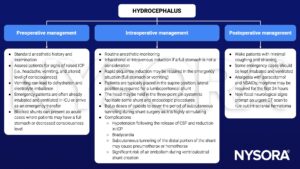Learning objectives
- Define hydrocephalus
- Describe the age-related signs and symptoms of hydrocephalus
- Anesthetic management of a patient with hydrocephalus
Definition and mechanisms
- Hydrocephalus is the excess accumulation of cerebrospinal fluid (CSF) in the ventricular system of the brain, resulting in increased intracranial pressure (ICP)
- It is caused by obstruction to CSF flow in the ventricles or subarachnoid space, or by excess CSF production from a congenital malformation blocking normal drainage or from complications of head injuries or infections
- Hydrocephalus can happen at any age but occurs more frequently among infants and older adults (>60 years)
Signs and symptoms
The signs and symptoms vary by the age of onset
Infants
- Changes in the head
- Unusually large head
- Rapid increase in the size of the head
- Bulging or tense soft spot (fontanel) on the top of the head
- Physical signs and symptoms
- Nausea and vomiting
- Sleepiness or lethargy
- Irritability
- Poor eating
- Seizures
- Reduced upward gaze (Parinaud’s syndrome)
- Problems with muscle tone and strength
Toddlers and older children
- Physical signs and symptoms
- Headache
- Blurred or double vision
- Abnormal eye movements
- Abnormal enlargement of the head
- Sleepiness or lethargy
- Nausea or vomiting
- Unstable balance
- Poor coordination
- Poor appetite
- Loss of bladder control or frequent urination
- Behavioral and cognitive changes
- Irritability
- Change in personality
- Decline in school performance
- Delays or problems with previously acquired skills (e.g., walking, talking)
Young and middle-aged adults
- Headache
- Lethargy
- Loss of coordination or balance
- Loss of bladder control or frequent urination
- Vision problems
- Decline in memory, concentration, and other thinking skills
Older adults (>60 years)
- Loss of bladder control or frequent urination
- Memory loss
- Progressive loss of other thinking or reasoning skills
- Gait disturbance
- Poor coordination or balance
Causes
Noncommunicating hydrocephalus: Obstruction of CSF outflow
- Space-occupying lesion
- Subarachnoid or intraventricular hemorrhage
- Spina bifida
- Arnold-Chiari malformation
- Dandy-Walker malformation
- Head injury
- Aqueductal stenosis
- Tumors
Communicating hydrocephalus: Failure of absorption of CSF by the arachnoid villi
- Subarachnoid or intraventricular hemorrhage
- Meningitis
- Head injury
- Achondroplasia
- Craniofacial syndromes
- Other skull base deformities
- Choroid plexus papilloma or carcinoma
Risk factors
Newborns
- Abnormal development of the central nervous system that obstructs the CSF flow
- Bleeding within the ventricles (i.e., intraventricular hemorrhage), a possible complication of premature birth
- Infection in the uterus (e.g., rubella or syphilis) during pregnancy may cause inflammation in the fetal brain tissues
Other contributing factors
- Lesions or tumors of the brain or spinal cord
- Central nervous system infections (e.g., bacterial meningitis or mumps)
- Bleeding in the brain from a stroke or head injury
- Other traumatic injury to the brain
Treatment
- Short-term (acute and emergency situations): External ventricular drain or ventriculostomy
- Inserted into the frontal horn of the lateral ventricle
- Drain reduces the ICP and allows to measure ICP
- Only short-term management due to the risk of infection
- Long-term: Cerebral shunt
- Allows drainage of CSF to distal sites
- Placement of a ventricular catheter into the cerebral ventricles to bypass the flow obstruction/malfunctioning arachnoid villi and drain the excess CSF into other body cavities from where it can be resorbed
- Most shunts drain fluid into the peritoneal cavity (ventriculoperitoneal shunt), alternative sites include the right atrium (ventriculoatrial shunt), pleural cavity (ventriculopleural shunt), and gallbladder
- The shunt can also be placed in the lumbar space of the spine to redirect the CSF to the peritoneal cavity (lumboperitoneal shunt)
Management

Suggested reading
- Krovvidi H, Flint G, Williams AV. Perioperative management of hydrocephalus. BJA Educ. 2018;18(5):140-146.
- Pollard BJ, Kitchen G. Handbook of Clinical Anaesthesia. 4th ed. Taylor & Francis group; 2018. Chapter 14 Neurosurgery, Chapman E.
We would love to hear from you. If you should detect any errors, email us customerservice@nysora.com



